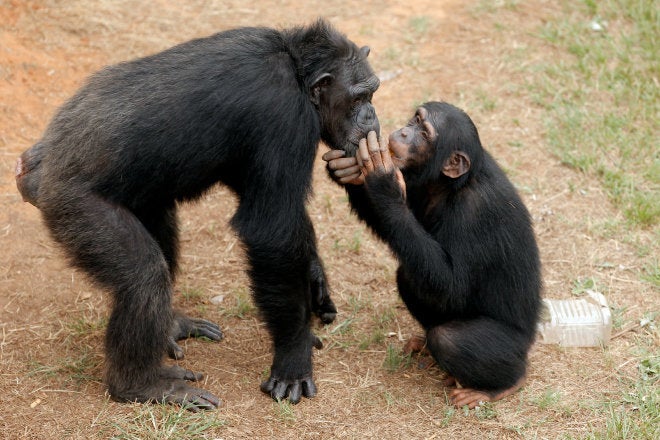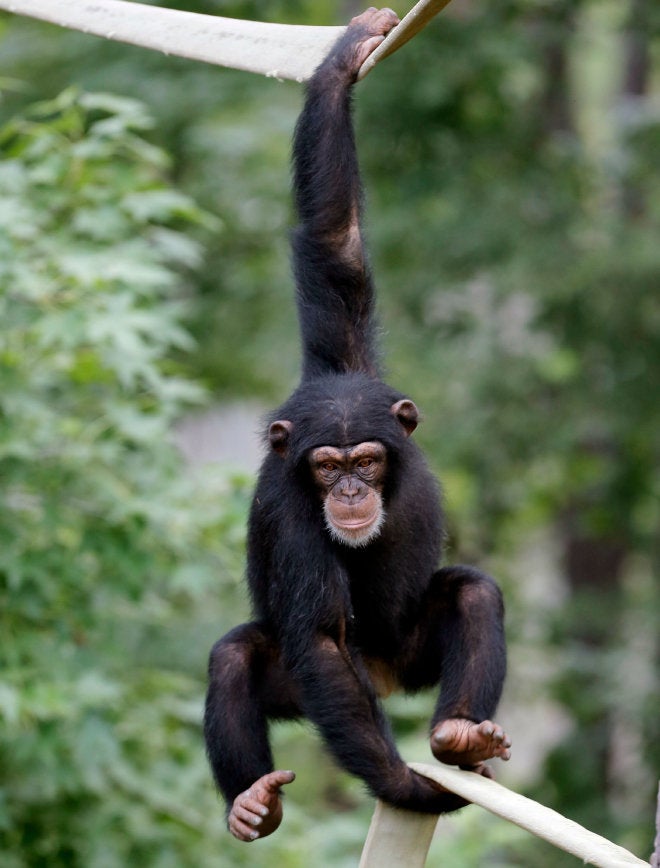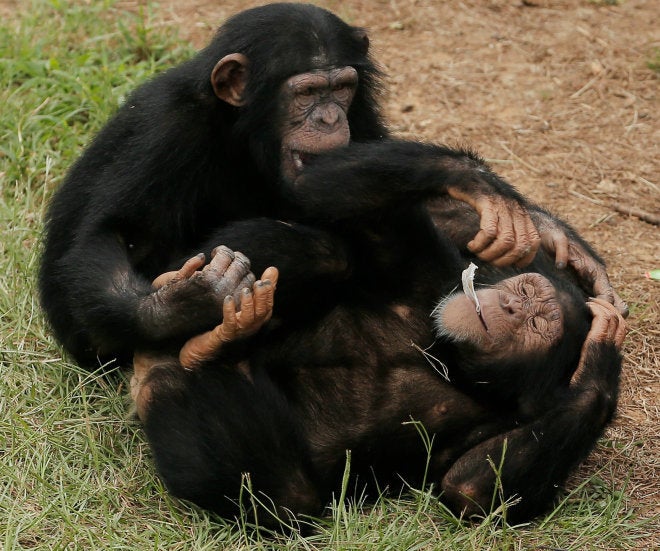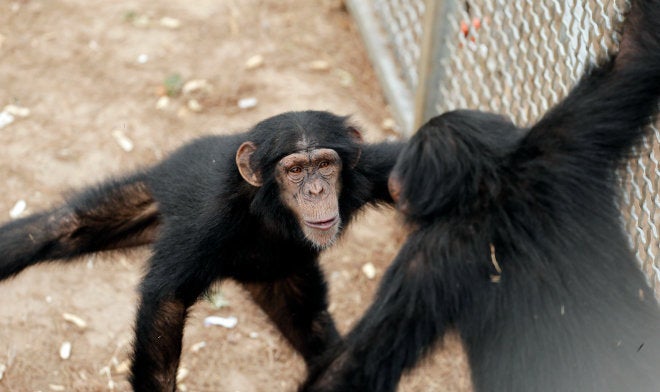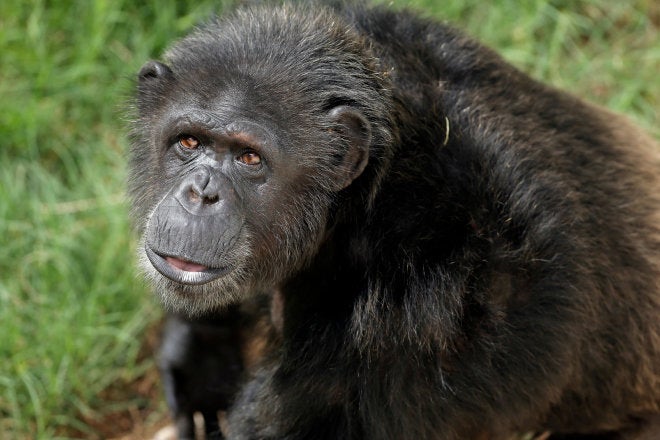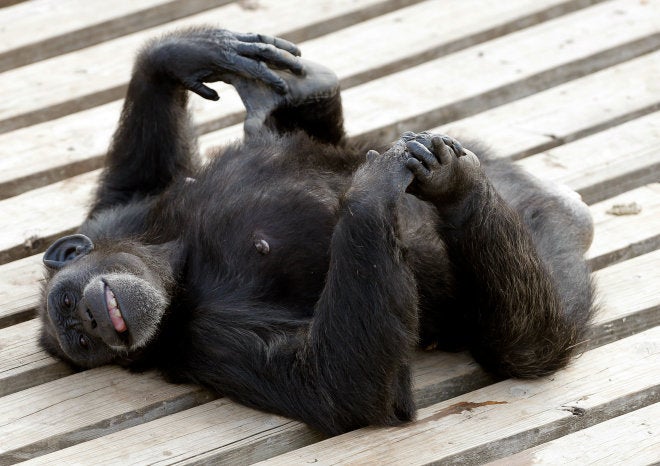Move somewhere new, and it's not long before you pick up some local slang. As it turns out, chimpanzees might be able to do something similar.
Maybe we're not so different after all.
When a group of chimps from Beekse Bergen Safari Park in the Netherlands was sent to live with the chimps at the Edinburgh Zoo in 2010, they each had their own distinct grunts and calls that represented "apple."
But a new study from scientists at the University of York and University of Zurich that was published in Current Biology shows how, over time, the Dutch chimps changed their calls as they learned to vocalize "apple" in a way similar to their host chimps in Scotland.
Here, for example, is a chimp named Frek vocalizing the word "apple" when he first arrived in 2010:
Compare Frek's high-pitched cries to the vocalizations used by one of the locals, a chimp named Lucy:
As the chimps intermingled, the grunts for "apple" became similar. Three years later, Frek's version matched Lucy's:
Dr. Simon Townsend, one of the study's co-authors, told the BBC that they're still not sure if this means the chimps have learned another sound for "apple" -- like a human who speaks English learning the word in French -- or if they've simply picked up the local accent in the Scottish zoo.
“These findings might shed some light on the evolutionary origins of these abilities," Townsend said in a news release. "The fact that both humans and now chimpanzees possess this basic ability suggests that our shared common ancestor living over 6 million years ago may also have been socially learning referential vocalizations.”
The study builds on a growing body of work into the vocalizations of primates and how they can change and develop over time.
While it's tempting to compare these vocalizations to speech and language, scientists say the reality is far more complicated.
Dr. Adriano Lameira, co-founder and president of the orangutan research organization Pongo Foundation and one of the authors of last month's study, said the new research "generates a striking parallel with how humans learn words and attribute them with meaning."
At the same time, it may not have been entirely conscious, that the amount of time it took for the vocalizations to change suggest "physiological processes or passive adaptation (possibly oxytocin-regulated since convergence was dependent on the quality of the relationships between the individuals), not so much voluntary acts," Lameira told The Huffington Post.
Chimps can also pass their calls on through generations.
"This is still remarkably different from what humans do –- we modify at will and instantly new and learned calls," Lameira said.
Dr. Rob Shumaker, supervising vice president of conservation, science, and education at the Indianapolis Zoo and a co-author on the orangutan paper, said that -- as with humans -- a common vocabulary allows chimps to communicate more effectively.
"While it’s not surprising that chimpanzees prioritize group cohesion, it is quite remarkable to see it documented through these evolving vocalizations," Shumaker said.
"Overall, the paper speaks to the cognitive complexity that is present in chimpanzees and great apes in general," Shumaker said. "Further, it affirms the notion that any differences we see between the mental skills of humans and the other great apes are ones of degree, not kind."
Our 2024 Coverage Needs You
It's Another Trump-Biden Showdown — And We Need Your Help
The Future Of Democracy Is At Stake
Our 2024 Coverage Needs You
Your Loyalty Means The World To Us
As Americans head to the polls in 2024, the very future of our country is at stake. At HuffPost, we believe that a free press is critical to creating well-informed voters. That's why our journalism is free for everyone, even though other newsrooms retreat behind expensive paywalls.
Our journalists will continue to cover the twists and turns during this historic presidential election. With your help, we'll bring you hard-hitting investigations, well-researched analysis and timely takes you can't find elsewhere. Reporting in this current political climate is a responsibility we do not take lightly, and we thank you for your support.
Contribute as little as $2 to keep our news free for all.
Can't afford to donate? Support HuffPost by creating a free account and log in while you read.
The 2024 election is heating up, and women's rights, health care, voting rights, and the very future of democracy are all at stake. Donald Trump will face Joe Biden in the most consequential vote of our time. And HuffPost will be there, covering every twist and turn. America's future hangs in the balance. Would you consider contributing to support our journalism and keep it free for all during this critical season?
HuffPost believes news should be accessible to everyone, regardless of their ability to pay for it. We rely on readers like you to help fund our work. Any contribution you can make — even as little as $2 — goes directly toward supporting the impactful journalism that we will continue to produce this year. Thank you for being part of our story.
Can't afford to donate? Support HuffPost by creating a free account and log in while you read.
It's official: Donald Trump will face Joe Biden this fall in the presidential election. As we face the most consequential presidential election of our time, HuffPost is committed to bringing you up-to-date, accurate news about the 2024 race. While other outlets have retreated behind paywalls, you can trust our news will stay free.
But we can't do it without your help. Reader funding is one of the key ways we support our newsroom. Would you consider making a donation to help fund our news during this critical time? Your contributions are vital to supporting a free press.
Contribute as little as $2 to keep our journalism free and accessible to all.
Can't afford to donate? Support HuffPost by creating a free account and log in while you read.
As Americans head to the polls in 2024, the very future of our country is at stake. At HuffPost, we believe that a free press is critical to creating well-informed voters. That's why our journalism is free for everyone, even though other newsrooms retreat behind expensive paywalls.
Our journalists will continue to cover the twists and turns during this historic presidential election. With your help, we'll bring you hard-hitting investigations, well-researched analysis and timely takes you can't find elsewhere. Reporting in this current political climate is a responsibility we do not take lightly, and we thank you for your support.
Contribute as little as $2 to keep our news free for all.
Can't afford to donate? Support HuffPost by creating a free account and log in while you read.
Dear HuffPost Reader
Thank you for your past contribution to HuffPost. We are sincerely grateful for readers like you who help us ensure that we can keep our journalism free for everyone.
The stakes are high this year, and our 2024 coverage could use continued support. Would you consider becoming a regular HuffPost contributor?
Dear HuffPost Reader
Thank you for your past contribution to HuffPost. We are sincerely grateful for readers like you who help us ensure that we can keep our journalism free for everyone.
The stakes are high this year, and our 2024 coverage could use continued support. If circumstances have changed since you last contributed, we hope you'll consider contributing to HuffPost once more.
Already contributed? Log in to hide these messages.
